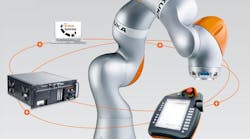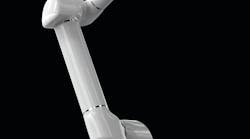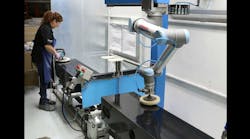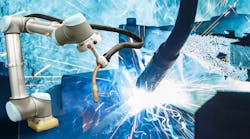Latest from Plant Operations
My Robot Colleague Has It All Under Control
High market dynamics, increasing competition due to globalization, but also demographic developments and the growing shortage of skilled workers, are presenting German production companies with major hurdles. These changes particularly affect the assembly process as the last link in the value chain.
One approach to counter this change is the use of so-called human-robot collaboration (HRC). However, HRC systems are currently still associated with high monetary and personnel costs due to their planning complexity.
Therefore, there is a need for simple as well as flexible methods and procedures that enable companies from a wide variety of industries with a wide variety of application boundary conditions (product complexity, variance, quantities, etc.) to set up and introduce collaborative assembly workstations.
Research Project SafeMate
In the SafeMate research project, which is funded by the German Federal Ministry of Education and Research (BMBF) in the "Innovations for the Production, Service and Work of Tomorrow" program, strategies and concepts were developed for the introduction and design of collaborative assembly workplaces.
The focus was on safe and accepted workplaces where employees recognize a high benefit. In addition to renowned German companies such as Lenze, Lufthansa Sky Chefs, Miele, and Sennheiser, the Detmold-based company Weidmüller was also part of this research project.
The Weidmüller Group is a global player and specializes in the field of electrical connection technology and electronics. Together with its customers, it is shaping the digital transformation—with products, solutions, and services for Smart Industrial Connectivity and the Industrial Internet of Things.
With its products, Weidmüller is predominantly active in mechanical engineering, the process industry, power generation and renewable energies, transport technology, building infrastructure, and in the field of device manufacturing. The company has long been involved with the topic of Industry 4.0. and, in addition to SafeMate, is involved in other research collaborations.
In the Beginning, Everything Was Done by Hand
Until recently, the assembly process for electromechanical components at Weidmüller was carried out completely manually by employees at the assembly workstation. As part of SafeMate, a potential analysis—carried out by the team led by Weidmüller process engineer Tobias Stuke—was to determine the individual tasks performed by man and machine and thus create a task-optimal division of labor.
Among other things, it was found that robots are very good at performing the monotonous, repetitive, and power-intensive tasks of the placement process without fatigue. And they can do so with consistent accuracy. But it can't be done without humans: humans have special skills, for example, in gripping and removing small parts of different dimensions from a pile/box. They can recognize and sort them better. Humans are also superior to their robotic colleagues when it comes to correct feeding and the subsequent inspection process.
Based on these findings, the previously manual assembly process was then partially automated in an initial SafeMate pilot application by using human-robot collaboration (HRC).
The result was a hybrid assembly workplace in which humans and robots work in parallel. The monotonous and force-intensive tasks are performed by the robot, while the cognitively demanding tasks are carried out by the human.
Human-Robot Collaboration (HRC)
In collaborative robotics, humans and robots can work hand in hand at one workplace. Due to the sensitive control technology, the robot can work closely with humans without protective fences. The application requires validation to ensure that hazards have been sufficiently minimized.
This can be done as part of a measurement of force and pressure carried out by TÜVs, professional associations, external service providers or independently by the integrator. End-of-arm tools, such as a gripper, can also be validated in this way.
For the new hybrid workplace, for the assembly of electromechanical components, such as a cobot from the Danish robot manufacturer Universal Robots (UR), has now been placed at the side of the employees to work alongside them. First, the colleague assembles the connector elements. Then the cobot presses in the electrical contact elements, joins the connector housing, and screws the connection contacts.
The productivity of the entire hybrid workstation is increased by the use of a collaborative robot and the resulting reduction in intermediate steps or waiting times in the assembly process. The focus of this partial automation is to relieve the machine operator of time-consuming and monotonous intermediate steps and to achieve a balanced division of labor between humans and robots.
A Cobot With Zimmer HRC Gripper
In addition to the selection of a suitable robot, a suitable gripper was also required as part of the workstation design. This is because gripping technology is an elementary component of every robot application.
The HRC-02 gripper from the Zimmer Group, a gripper specialist based in Rheinau, Germany, was found relatively quickly. Zimmer Group currently has the largest portfolio of HRC grippers in the World. The selected gripper is safe and harmonizes perfectly with the selected UR robot.
The HRC-02 all-electric servo gripper, specially designed for MRK use, has no sharp edges and is constructed in such a way that, with its rounded shape on all sides, accidental snagging is virtually impossible. In addition, the HRC-02 has a flexibly adjustable stroke and gripping force, allowing it to grip much more sensitively than a conventional gripper.
These features paired with an industry-proven design provide the maximum safety for this project. All HRC grippers from the Zimmer Group meet the high requirements of the protection principles according to ISO/TS 15066 (HRC standard) and are BG/DGUV certified.
Programming Made Easy
In Weidmüller's SafeMate project, another focus was on being able to use the UR cobot efficiently and flexibly at the new hybrid workplace. Therefore, attention was also paid to the easy handling of the robot.
The ease of operation of the cobot was convincing, especially in combination with the HRC-02 gripper. After all, it is no coincidence that all Zimmer Group grippers can work perfectly with UR lightweight robots—as a UR+ partner, Zimmer Group currently displays the largest portfolio of UR-compatible grippers on the UR+ website.
Where previously elaborate programming work and complex programming skills were required, the cobot from Universal Robots and its Zimmer gripper is very easy to operate. It is controlled or programmed directly through the robot control panel, which is intuitively designed - comparable to a smartphone app.
Increased Productivity and Satisfaction
The pilot use of the cobot in Weidmüller's mechanical engineering department opens up new possibilities, also in terms of efficiency and flexibility. Thanks to this new, hybrid division of labor and the simple operability and easy installation of the intelligent robot and its gripper, the electronics manufacturer can now meet the increasing shortage of skilled workers and global competition a bit more.
In addition to the increase in productivity, there were also important non-monetary successes, such as ergonomic workplace optimization and general work relief for employees.
For example, force-intensive tasks such as pressing in the contact elements ("latching") and monotonous tasks could be handed over to the robot. This high level of employee acceptance was also achieved through a participatory implementation process. This means that employees were involved in the change process around their workplace from the very beginning.
Future Use of Cobots and Grippers
A particular selection criterion for the Zimmer Group's gripper was that, in addition to its technical features, the gripper already had the tested and certified safety for HRC systems, which means that we were already on the "safe side"—in the truest sense of the word—for our gripping technology project," says Stuke. It is particularly important to the company that its employees benefit from collaborative work. The cobots with their grippers are intended to provide relief.














